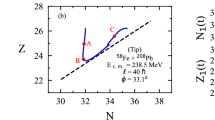Abstract
The dynamical description of light, intermediate, heavy and superheavy nuclei formed in heavy-ion collisions is worked out using the dynamical cluster decay model (DCM), with reference to various effects such as deformation and orientation, temperature, angular momentum etc. Based on the quantum mechanical fragmentation theory (QMFT), DCM has been applied to understand the decay mechanism of a large number of nuclei formed in low-energy heavy-ion reactions. Various features related to the dynamics of competing decay modes of nuclear systems are explored by addressing the experimental data of a number of reactions in light, intermediate, heavy and superheavy mass regions. The DCM, being a non-statistical description for the decay of a compound nucleus, treats light particles (LPs) or equivalently evaporation residues (ERs), intermediate mass fragments (IMFs) and fission fragments on equal footing and hence, provides an alternative to the available statistical model approaches to address fusion–fission and related phenomena.






Similar content being viewed by others
References
S S Malik and R K Gupta, Phys. Rev. C 39, 1992 (1989)
R K Gupta, S K Arun, R Kumar and Niyti, Int. Rev. Phys. (IREPHY) 2, 369 (2008)
B B Singh, M K Sharma and R K Gupta, Phys. Rev. C 77, 054613 (2008)
M K Sharma, G Sawhney, R K Gupta and W Greiner, J. Phys. G 38, 105101 (2011)
K Sandhu, M K Sharma and R K Gupta, Phys. Rev. C 86, 064611 (2012)
M Kaur, R Kumar and M K Sharma, Phys. Rev. C 85, 014609 (2012)
R K Gupta and W Greiner, in Heavy elements and related new phenomenon edited by W Greiner and R K Gupta (World Scientific, Singapore, 1999) Vol. I, Chap. 14, p. 536
R K Gupta et al, Phys. Rev. C 68, 014610 (2003)
S K Arun, R Kumar and R K Gupta, J. Phys. G 36, 085105 (2009)
R K Gupta et al, J. Phys. G 31, 631 (2005)
H Kroger and W Scheid, J. Phys. G 6, L85 (1980)
G Royer and J Mignen, J. Phys. G 18, 1781 (1992)
N J Davidson et al, Nucl. Phys. A 570, 61c (1994)
W D Myers and W J Swiatecki, Nucl. Phys. A 81, 1 (1966)
A S Jensen and J Damgaard, Nucl. Phys. A 203, 578 (1973)
R M Anjos et al, Phys. Rev. C 48, R2154 (1993); Phys. Rev. C 49, 2018 (1994)
S Kumar and R K Gupta, Phys. Rev. C 55, 218 (1997)
B B Singh et al, Proceedings of DAE symposium on Nuclear Physics 55 (2012)
E F Aguilera et al, Phys. Rev. Lett. 107, 092701 (2011)
P Moller et al, At. Data Nucl. Data Tables 59, 185 (1995)
R K Gupta, M Manhas and W Greiner, Phys. Rev. C 73, 054307 (2006)
E F Aguilera et al, Phys. Rev. C 79, 021601(R) (2009)
G Kaur and M K Sharma, Nucl. Phys. A 884, 36 (2012)
P P Singh et al, Phys. Rev. C 77, 014607 (2008)
P K Rath et al, Nucl. Phys. A 874, 14 (2012)
G Kaur and M K Sharma, Phys. Rev. C 87, 044601 (2013)
M Kaur and M K Sharma, Phys. Rev. C 85, 054605 (2012) S Kanwar et al, Int. J. Mod. Phys E 18, 1453 (2009) G Sawhney and M K Sharma, Eur. Phys. J. A 48, 57 (2012)
H Morgenstern et al, Phys. Rev. Lett. 52, 1104 (1984)
Acknowledgement
Thanks are due to Prof. R K Gupta and Ph.D. students Kirandeep Sandhu and Manpreet Kaur for their valuable contributions in this work.
Author information
Authors and Affiliations
Corresponding author
Rights and permissions
About this article
Cite this article
SHARMA, M.K., KAUR, G. Dynamics of light, intermediate, heavy and superheavy nuclear systems formed in heavy-ion collisions. Pramana - J Phys 82, 919–930 (2014). https://doi.org/10.1007/s12043-014-0744-3
Published:
Issue Date:
DOI: https://doi.org/10.1007/s12043-014-0744-3




